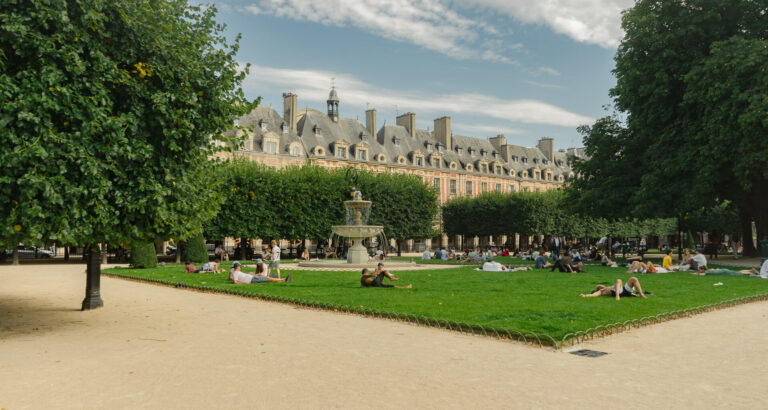Walking into Le Marais feels like stepping into a secret Paris few tourists ever truly grasp. Cobbled streets echo with layers of centuries, framed by noble townhouses, tucked-away gardens, and shopfronts that blur the line between past and present.
Art spills out of galleries, the smell of fresh bread leads you around corners, and voices drift from old cafés where time never quite caught up.
Locals still linger under the arches of Place des Vosges, lovers still pause beside ivy-covered walls, and hidden courtyards open without warning to reveal sculpture gardens or book stalls.
Every detail in Le Marais carries the weight of stories waiting to be found. You will not need a map here. Curiosity will guide you to everything that matters.
Forget the Eiffel Tower. Forget the Seine. Le Marais offers something deeper. The moments you collect in its alleys and doorways will stay with you long after you leave Paris behind.
And when your trip is halfway through or wrapping up, you can send a card to your loved ones and friends using the pictures you took with a free card generator.
Here are seven things that reveal the soul of this unforgettable neighborhood.
1. Walk through Place des Vosges and sit near the fountains
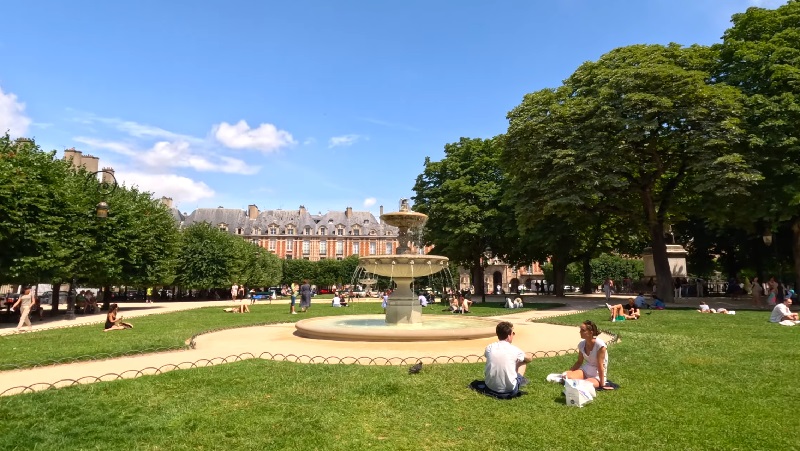
Place des Vosges holds the oldest square in Paris, but it never feels frozen. Trees line the center in perfect order, surrounding a green lawn crossed by quiet paths and fountains at each corner.
Built in 1605 under King Henri IV, the design remains untouched. Red brick buildings form a perfect square, each one nearly identical in height and form, with arched arcades below and steep slate roofs above.
This space once carried royal pride. Nobles walked the edges in silk. Servants kept close to the shadows. Today, families picnic on the grass. Children spin on scooters past the marble statues. The square allows both past and present to share the same silence.
Victor Hugo lived here at No. 6. He wrote part of Les Misérables inside those walls. That apartment is now a museum filled with drawings, furniture, and pages in his own handwriting. Sit beneath the arcades and imagine him above you, watching the trees shift through seasons that still repeat themselves without pause.
2. Eat falafel on Rue des Rosiers in the Jewish Quarter
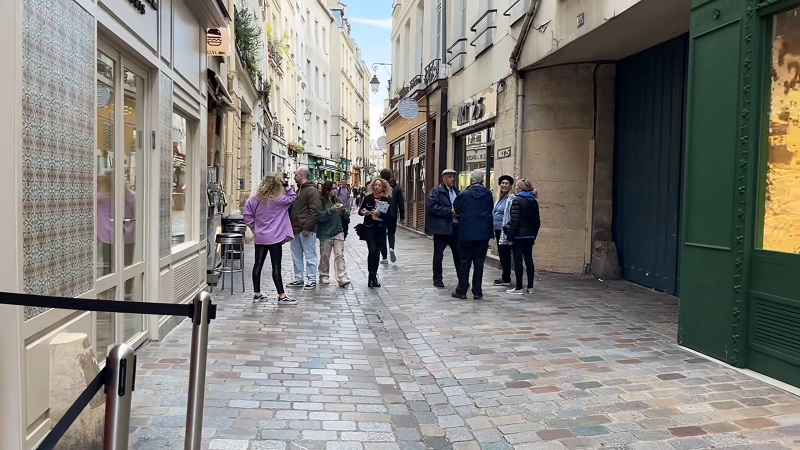
Rue des Rosiers speaks in spice, garlic, oil, and heat. It smells like frying pans and soft bread. You walk down the street and the scent grabs you. Every few steps brings another window full of baked goods, sweets, or falafel sandwiches stacked high in glass cases.
L’As du Fallafel leads the charge. A small green sign. A line that curves along the sidewalk. You wait, always, but the first bite makes time irrelevant. The pita is warm and heavy. Inside, crisp chickpea balls crack under your teeth beside grilled eggplant, shredded cabbage, tahini, and hot sauce. Each layer builds its own voice.
View this post on Instagram
This street holds more than food. Hebrew letters hang beside French ones on store signs. Bookshops sell Yiddish poetry next to cookbooks and prayer texts. The Jewish community has roots here deeper than memory. It survived turmoil. It shaped the street’s rhythm. Rue des Rosiers gives you something to eat, but it also gives you a story to carry forward.
3. Visit the Musée Picasso to see his personal collection
The Musée Picasso holds thousands of works the artist kept for himself. Paintings, sketches, sculptures, notebooks, and photographs fill the rooms of the Hôtel Salé, a 17th-century mansion with sharp stone staircases and tall, narrow windows. This museum does not only show Picasso’s best-known pieces. It shows the process, the revisions, the obsessions.
Each floor tells a different part of his story. One section follows his blue and rose periods. Another moves through cubism and collage. Then come the later years—bolder lines, sharper contrast, and sudden violence in both color and shape. The building feels like a labyrinth designed for slow curiosity.
Personal Items and Overlooked Details
Picasso’s personal letters hang next to works he never sold. Photographs show him at home, surrounded by brushes and clay. In one corner of the museum, a small bronze goat sits under glass. He sculpted it from scrap metal and wicker, naming it “La Chèvre.” It says more about his humor than any painting on the wall.
4. Browse antiques at Village Saint-Paul
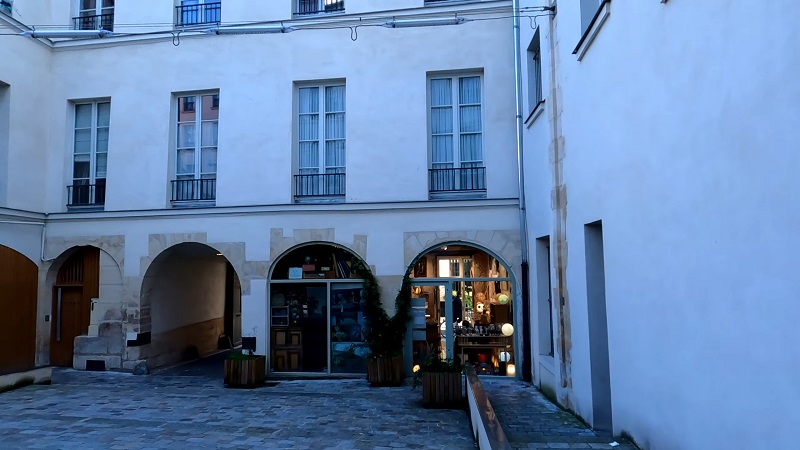
Village Saint-Paul hides behind stone walls and narrow gates between Rue Saint-Paul and Rue Charlemagne. Step through, and the noise drops. The space becomes a network of courtyards linked by archways. Antique shops, galleries, and furniture dealers fill the old stones with a quiet rhythm of their own.
You will not find mass-produced junk here. Each item carries weight. A rusted key might unlock a chest two centuries old. A ceramic plate might show a coat of arms buried under time.
Ask the shop owners anything—they remember every piece on every shelf. Each sale comes with a story, sometimes true, sometimes improved.
Why Collectors Keep Coming Back
Dealers often rotate their inventory with museum-grade items. Some buyers search for a single mirror, a single desk, a single book. Others come weekly, always hoping the right object appears at the right moment. Even if you walk out empty-handed, the search itself becomes part of the reward.
5. Check out the Hôtel de Sully courtyard and gardens
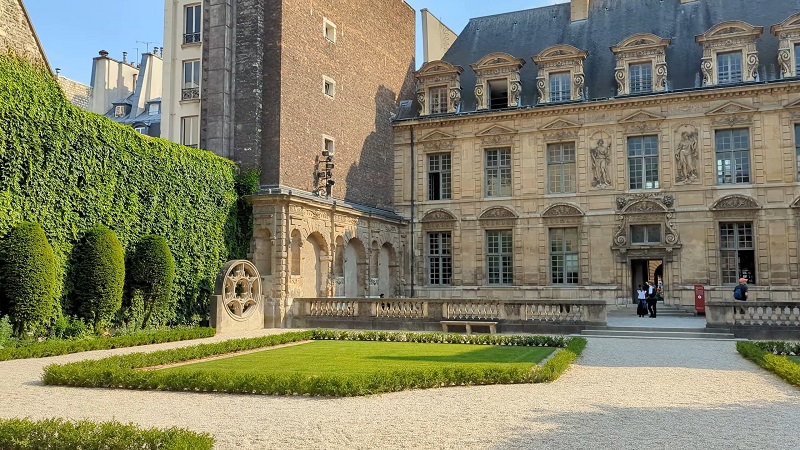
The Hôtel de Sully stands right beside Place des Vosges but remains overlooked by most. Its tall entrance gate opens into a quiet courtyard paved with stone, where trimmed hedges and statues soften the angles of the building. This 17th-century mansion once belonged to Maximilien de Béthune, Duke of Sully, who served as minister under King Henri IV.
Now it houses the Centre des Monuments Nationaux, but visitors can still access the gardens for free. The symmetry of the space mirrors the design of the square nearby, but without crowds or noise. A hidden path at the far end leads back into Place des Vosges through a small iron gate few notice.
Architecture that Rewards Attention
Look up at the windows trimmed with sculpted stone faces. Each corner includes carved details—dragons, laurels, suns. Inside the gallery spaces, murals and decorative ceilings remain intact, though access can depend on exhibits or events.
Even the roof, with its tall chimneys and blue slate, reflects the style of power and wealth carved into Paris at the height of its monarchy.
6. Explore the Marché des Enfants Rouges for fresh food and snacks
Marché des Enfants Rouges hides behind an iron gate on Rue de Bretagne. Built in 1615, it stands as the oldest covered market in Paris, though it feels more alive than historic. Inside, the narrow paths press between food stalls, stacked produce, hot griddles, and trays of color.
Moroccan tagines steam beside Japanese bento boxes. French cheeses sit near Caribbean jerk chicken.
You can grab a plate of couscous and sit at a shared table, shoulder to shoulder with strangers. You can order fresh oysters, then turn around and get a square of chocolate cake.
It feels chaotic, but it works. The noise carries the comfort of people feeding each other in every language possible.
The Name and The Legacy
The name “Enfants Rouges” refers to the red uniforms once worn by children at a nearby orphanage. That detail remains part of the neighborhood’s memory, written into its signs and market identity. The past still holds a seat beside the lunch counter.
7. Step inside Saint-Paul-Saint-Louis Church and look up at the ceiling
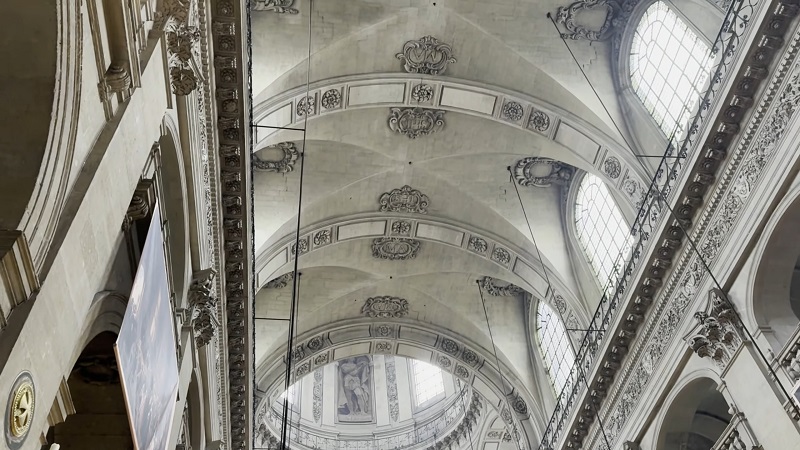
Tucked between shops on Rue Saint-Antoine, the Saint-Paul-Saint-Louis Church rises with little warning. Its doors lead into a baroque interior built in the early 1600s by Jesuits, filled with deep golds, blood reds, and massive white columns. Inside, the air shifts.
The echo wraps around each step. Candles line the corners. The ceiling curves overhead in grand arches decorated with paintings and carved stonework.
You will see tourists, but mostly you will see silence. Some sit in the pews without moving. Some walk to the altar and light a small flame for someone they remember. The entire space breathes through its shadows.
What Others Miss
Few visitors notice the Delacroix painting to the right of the nave. It hangs quietly without spotlight or display, blending into the wall unless you stop and look. “Christ in the Garden of Olives” was finished in 1824.
His face appears hollow, his hands clenched. It waits in stillness, like the church itself. Every detail holds its place without needing attention. The reward goes to those who look slowly.
FAQs
Where can I find the best coffee near Place des Vosges?
Café Carette sits directly on the northwest corner of Place des Vosges. Locals order noisettes and millefeuille. The terrace offers front-row views of the square. Indoors, chandeliers hang above marble tables. Service runs slow but precise.
Is Rue des Rosiers open on Saturdays?
Most food spots on Rue des Rosiers stay open Saturday, but many close early before sundown. Sunday is quieter. Friday afternoon and Saturday midday offer the best window if you want a fresh falafel without the full crowd.
Can I enter the inner courtyard of Hôtel de Sully without a ticket?
Yes. The front gate stays open to the public during the day. You can enter the first courtyard and walk through to the garden at the back. No entry fee. The building’s interior and exhibitions may require a ticket, depending on current shows.
What time should I arrive at Marché des Enfants Rouges to avoid crowds?
Arrive before 11:00 AM on weekdays. Vendors prepare slowly before lunch. By noon, lines form at every counter. On weekends, aim for 10:30 AM to get a seat. Later than that, expect to stand or share cramped space.
Is Saint-Paul-Saint-Louis Church open every day?
Yes. Doors typically open from 8:00 AM to 8:00 PM. Mass times vary, and the building may close briefly between services. Entry is free. Quiet hours mid-afternoon give you the best chance to see the artwork without crowds.
Last Words
Le Marais offers specific value for travelers who want depth beyond famous monuments. The area provides direct access to history, art, food, and daily Parisian life without requiring complex planning. Each activity in this guide connects to a real location that remains open, accessible, and tied to the district’s identity.
Visitors can see original works by Picasso, eat from the oldest market in the city, walk through preserved architecture, and sit in a square that shaped French urban planning. The mix of cultural layers within a walkable space makes Le Marais one of the most concentrated and rewarding neighborhoods in Paris.
No extra effort is needed to enjoy it. Follow the streets. Look for open doors. Ask questions inside galleries and shops. Every part of the district invites direct participation without artificial experiences.
Read Next – Best Restaurants in 1st Arrondissement

